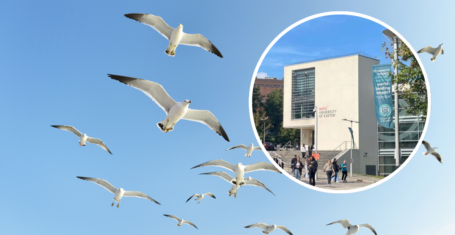
Okay but, who even is Russell and what is his Group? The Russell Group, explained
Apparently it’s named after a hotel?
If you go to any university in the UK, you’ll without a doubt have heard of the Russell Group. If you go to a Russell Group uni you probably brag about it to your friends that don’t even though you don’t actually have the foggiest clue what it is.
If you don’t go to a Russell Group, you spend all of your time getting flustered trying to explain to your friends that it doesn’t actually mean it’s a better uni. Whatever helps you sleep at night.
But what actually is the Russell Group? Which unis are a part of it? And is it named after some random bloke called Russell?
What is the Russell Group?
The Russell Group is a group of 24 internationally recognised UK universities all with a focus on research. Between them, they make up more than two-thirds of the world’s research produced in UK universities.
According to its website, “Our universities believe people and ideas are the key to meeting global challenges. Through world-class research and education they are helping to create a dynamic economy, stronger communities and a better future for the UK. They maintain the very best research, an outstanding teaching and learning experience and unrivalled links with local and national business and the public sector.”
The group has headquarters based in Cambridge and was set up in 1994 to represent the interests of universities in Parliament.
Is the Russell Group named after a man called Russell?
Ok so, I’m sad to report that the Russell Group isn’t named after a guy named Russell. Shame, he sounded quite cool. The Russell Group gets it name from the hotel where all the original universities met to form the group.
Most Read
In 1994, 17 UK universities met at the Hotel Russell in London. Now known as the Kimpton Fitzroy London Hotel on Russell Square, it’s a boujee five star hotel with average prices ranging from £600-£839 a night.
Peak when your uni accommodation is riddled with rats and silverfish and the RG founders were sipping champers here.

Russell Hotel via Guilherme Stecanella on Unsplash
The original founding RG unis were: Birmingham, Bristol, Cambridge, Edinburgh, Glasgow, Imperial College London, Leeds, Liverpool, London School of Economics, Manchester, Newcastle, Nottingham, Oxford, Sheffield, Southampton, University College London and Warwick. In 1998 Cardiff and King’s College London joined the group and in 2006 Queen’s University Belfast also joined. Then in 2012, Durham, Exeter, Queen Mary University of London and York completed the group.
So, can any uni join the Russell Group?
So whilst the Russell Group is self-appointed and involved unis getting together and naming themselves as Russell Groups, any old uni can’t just decide to join in on the fun. Even though it is self selected, if a university wants to join it as to meet strict research and academic standards and be approved by the rest of the group. It hasn’t taken on any new members since 2012.
Is my uni in the Russell Group?
There are 24 universities in the Russell Group. These are:
- University of Birmingham
- University of Bristol
- University of Cambridge
- Cardiff University
- Durham University
- University of Edinburgh
- University of Exeter
- University of Glasgow
- Imperial College London
- King’s College London
- University of Leeds
- University of Liverpool
- London School of Economics
- University of Manchester
- Newcastle University
- University of Nottingham
- University of Oxford
- Queen Mary University of London
- Queen’s University Belfast
- University of Sheffield
- University of Southampton
- University College London
- University of Warwick
- University of York
What’s the difference between a Russell Group and red brick uni?
Red brick universities are just universities set up in industrial cities that were known for their engineering courses at the time. They date back to the Victorian era when they gained independence and became fully fledged universities. The name red brick just comes from the type of brick used on the buildings at the time. The inspiration behind this was the Victoria Building at The University of Liverpool.
The six original red brick universities are Birmingham, Bristol, Leeds, Liverpool, Manchester and Sheffield. All these unis are now also RG universities.
What does it actually do?

Basically, the only difference between a Russell Group uni and a non-RG is the amount of research the staff are doing. The Russell Group unis make around £87 billion every year for the UK economy. Generally, they also have a stricter admissions policy.
Does being in the Russell Group make it a better uni?
Whilst a lot of the RG universities rank highly in university league tables, it doesn’t necessarily mean they are better unis. St Andrews, which was ranked as the best university in the UK this year in both The Guardian’s league table and The Times Good University Guide, isn’t in the Russell Group.
Other notable universities that also rank highly, including Lancaster and Bath are also not part of the Russell Group.
Featured image before edits via Korng Sok on Unsplash.
Related stories recommended by this writer:
• The whitest universities: The Russell Groups with the fewest ethnic minority students
• We asked ChatGPT for each Russell Group uni’s stereotype and some are genuinely offensive
• The Russell Group universities with the highest dropout rates, revealed

















